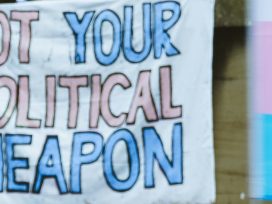These days, cultural and political paranoia, with its obligatory elements of conspiracy theory, is the subject of numerous psychological, cultural, sociological and philosophical studies in very different areas of the social sciences. It would be difficult to imagine a field in which we would not come across it. However, it does not have as strong a presence in some areas, particularly in Europe. Although it is a challenge to describe it adequately, since it is conceptually elusive, it nevertheless persists before us as a clear discursive matrix and recognizable phantasmatic framework with which we can quickly recognize and identify certain acts and thought patterns. Many contemporary authors refer to nothing less than the culture of paranoia into which we have gotten bogged down, in the sphere of politics (regardless of orientation), mass and other media, established or marginal cultural practices, and social life of all kinds. The plus side of this is the simplicity of diagnostics: cases of paranoia and conspiracy theories do not need special explanation or effort to recognize them. They are openly visible and known to all. Even more so is our susceptibility to its spells: we discern conspiracy through various religious dogmas about the end of the world, through bizarre new age ideas, through fantastic stories about extraterrestrial beings, crop circles and UFOs, through stories of intentionally triggered global epidemics and the chemical poisoning of citizens, and conspiracies of particular governments or nations. Such theories are most rapidly used to explain certain unusual, dramatic, and tragic events, from the assassination of J. F. Kennedy, the Vietnam War, and the Watergate affair to the modern paradigm, the terrorist attack on New York on 11 September 2001.
However, these are just explicit forms of the phenomenon. It is important to realize that political paranoia and its wider effects in culture and society should not be viewed through clinical eyeglasses. The relevance of the concept long ago left behind the Freudian individual application and psychoanalytical contexts. Today, paranoia is no longer considered a disease but rather at most a mental disorder, and we are no longer willing to talk about its effects in society through collectively present thinking patterns of behaviour and reasoning as something which in its deviation from the norm is in need of therapy, if that would indeed even be possible, given its collective presence. In short, conspiracy theories at some level do expose a mass paranoid view of the world, but we needn’t view them as an expression of something pathological in nature but rather as a unique form of subjectivity and its manifest expression. Usually they arise outside mass culture, but they are at times easily placed at its centre. A quick psychoanalytical explanation in the analysis of mass psychology offers them to us as a forced response to the anxious feelings of some collective, perhaps an ethnic group, nation, or nationality, arising from a specifically stressful experience, by means of which we try to escape an encounter with reality. This sort of interpretation has nowadays been transcended, since for the majority of authors, such as Slavoj Zizek, Peter Knight, Timothy Melley and Michael Barkun, paranoia functions as an element of everyday American life – it is simply a part of cultural algorithm, and it is no coincidence that the examples most commonly cited in connection with it are predominantly American in origin.
In a well known essay entitled “Welcome to the Desert of the Real”, Zizek provides an illustration of what he boldly calls “the ultimate American paranoiac fantasy” – he finds it in Peter Weir’s film The Truman Show (1998). What the average American can fear, writes Zizek, is the possibility that one day in the middle of a small idyllic Californian city he will wake up with the suspicion that the world around him is in fact a fake, a spectacle staged to convince him that he lives in a real world. The fellow inhabitants he meets on the street are merely well-rehearsed actors, hidden cameras follow him everywhere without his knowing, all the details of his everyday life, though they appear accidental, are in fact carefully planned, and he is just an actor in a big reality show, although he is ignorant of this fact. He is justifiably horrified by this “unreality” which surrounds him, created by a late capitalist paradise, entirely hyper-real and devoid of substance. Paranoia as a symptom of a (new) subjectivity and social conditions is thus something not denoting a social ill but on the contrary it represents our being trapped in some phantasmatic framework within which we organize our own enjoyment, as Lacan would put it, which is reflected primarily through the manner of perceiving social reality, which in itself is already “sick.” In this sense, therapy and our form of perception are entirely appropriate and in fact make a lot of sense.
Conspiracy theory is just one possible form of paranoia, but a very widespread and palpable one. It often contains elements of a Manichean view of the world, since it depicts an eternal struggle between the forces of good and the forces of evil, says Barkun, which we perceive around us. A variation on the theme is the division between “us” and “them”. Its trademark can be the conviction of the ever-present apocalyptic dimensions of the current situation; typical of it also is a tireless demand for the creation of systems of thinking which at their base are even logically derived and in this sense “rational”, but nevertheless entirely incredible in their insistence on a causal connection of everything with everything. As Patrick O’Donnell concludes, the classical view of conspiracy theories as something triggered by shocking and traumatic historical events in America has outlived its usefulness; it would be more appropriate to see these theories as a symptomatic reaction in ourselves to the postmodern era and as an expression of the late capitalist state of culture in which the social space has been transformed in accordance with the demands of the mass media and new communications. Civil society engagement has replaced the reality of personal consumption, which guides and regulates our political, social and cultural engagement – it offers everyone the possibility of individual choices on the free market, but in so doing instead of freedom it forces the individual into uncertainty and the impossibility of choice, as Renata Salecl would say. For this reason a crisis of identity has appeared in the postmodern era, and this concept has experienced a radical alteration: the previously guaranteed autonomy of subjectivity, built on the basis of Enlightenment ideals in the modern age, has now been subjected to rupture and an attempt to establish a new subjectivity in the wider temporal and spatial environment of the search for other ways of finding meaning based on new structures and events, as Sam Coale concludes. At some point the negative treatment of paranoia therefore tips over into its opposite, a kind of survival strategy, into the literarized comprehensive representation of the world and its non-random coincidences in the desire to halt the fragmentation of spatial and temporal experience. On the other side are those who nevertheless think differently and believe that paranoia destroys “cognitive mapping”, that it is and remains a mistaken insight and illegitimate form of knowledge en route to paranoid and cynical subjectivity, always deserving of criticism.
In his cult book Richard Hofstadter gave a nice description of the “paranoid style” in American politics in the case of the difference between the clinical paranoiac and the paranoid political speaker. The first sees all around him a hostile and conspiratorial world which is turned against him, while the second rushes to explain that that same world has turned against the nation, culture, way of life – not just against his but that of millions of others. Paranoia, says Hofstadter, in both instances is marked by the same quality of heated exaggeration, suspicion, and a feeling of being threatened, conspiratorial fantasy, but there is nevertheless a distinct difference between clinical paranoia and its political equivalent. The assessment that someone is using paranoia for political purposes does not yet indicate a clinical history. The paranoid style has collective and symbolic tones and is in no way a concept that would be attached to an individual. But we make a fundamental mistake if we see it as only a rhetorical flourish and interpret it as something which has no connection to reality – although Hofstadter also mentions the possibility of a transition from political rhetoric to political pathology. No, the style is meant as something which describes reality to subjects. However, Hofstadter makes it clear that paranoia has serious ideological implications, it appears to us as a threat which arouses fear, it is a reaction to our feeling that our well established and taken for granted lifestyle will be destroyed. For instance the apocalyptic predictions of the end of the world, of the collapse of the political system, of the war between good and bad, either at the level of the cosmic and world or at the level of global or local politics, create the concept of the enemy, the Other in numerous personifications, who is always stealing our enjoyment. The figure of the hostile Other of course organizes and gives meaning to our actions and thoughts. Classical psychoanalysis explains our mental reactions by means of the defence mechanism of projection. Or rather, as Hofstadter concisely puts it, the paranoid style is the “imitation of the enemy.” Probably the most concrete representation was demonstrated by imitation in the years after 2001 with the so-called “war against terror” during the time of George W. Bush. The general obsession in further years was reflected in the military logic of the division of countries on the world map into, for example, those that were well-behaved and those that were considered rogues, for example, the military occupation of Iraq in 2003. But as some interpreters such as Peter Knight, have cautioned, Hofstadter’s analysis can be easily caught in the trap of repeating the paranoid gesture: by waging a campaign against the paranoid style, and demonizing and trying to drive it away, they risk echoing the same form of thinking that they want to condemn. And this is of course a trap in which many a theory of this type may be caught.
The selection of articles on cultural and political aspects of paranoia published here is the first of its kind in the Slovenian space or Slovenian language. It deals mainly with the “global” dimensions of the phenomenon, although Slovenia in recent years has itself become a fine example of a patient worthy of detailed analysis. Some events, especially those centred around so-called affairs, indicated its increasingly strong presence in the recent period, intensively after 2008: I have in mind the Patria affair, the weapons affair in its repetitions, the Baricevic affair, and similar. It is entirely clear that paranoid thinking and the psycho politics of paranoia in the forms they appear in Slovenia do not bring clear specifics, although we could cite some such. I mention this, since I owe the reader an explanation of my initial motivation. When as the editor of this thematic set I tried to confront the “truth” of this kind of reality, I found that there were not enough sufficiently qualified people in Slovenia who could discuss it adequately and competently. So I turned to some experts and writers who would be willing to write about the Slovenian reality, but was unsuccessful. After all most has been written about it in Slovenia by philosophers, for example from within the Lacanian school, and even these relatively little. I did not look to psychiatry and psychology but a specific Slovenian feature is that these usually do not write about social or collective phenomena – but in the case given it is just this segment which is treated. In the end my conclusion was that I would need to call on the help of foreign experts to suitably relate the Slovenian analysis of elements with the concept of paranoia generally. I was lucky to find the best. This is how the selection of texts arose, in which are exclusively represented authors who have intensively encountered the phenomenon along their expert and scientific paths; the majority have even written well-received books or articles on political and cultural paranoia.
Although my ambition was to write mainly about paranoia in politics, I am glad that things turned out differently. The articles presented are broad enough form a theoretical standpoint as to cover a much wider palette of its articulations. Contributors to this issue are thus Jerrold Post, professor of psychiatry, political psychology, and international relations at George Washington University in Washington, D.C. and together with R. S. Robins the author of Political Paranoia: The Psychopolitics of Hatred (1997), which gained a cult-like following. The next author is Mark Fenster, professor of law at the University of Florida, a specialist in legal and cultural theory and the author of Conspiracy Theories: Secrecy and Power in American Culture (2008, second edition), a chapter of which he has kindly allowed us to publish here. The same is true of Jack Bratich, professor of journalism and media studies at Rutgers (State University of New Jersey). The next author, Samuel Coale, researches American literature and culture at Wheaton College in Norton, near Boston (Massachusetts). He is the author of Paradigms of Paranoia: The Culture of Conspiracy in Contemporary American Fiction (2005). Timothy Melley is professor of English at Miami University in Ohio, where he is engaged in cultural and literary studies. He is the author of the book Empire of Conspiracy: The Culture of Paranoia in Postwar America (2000). Jonathan Bach teaches international relations and works on geopolitics, cultural politics, and cultural anthropology at the New School in New York and has written extensively on political paranoia. Alexander Dunst studies American literature and cultural studies, critical theory and intellectual history at the University of Nottingham in Great Britain. He is the co-author of the book Towards New Collective Subjects (“Special Issues of Subjectivity”, 2010). John C. Hampsey is a professor of English at California Polytechnic State University in California. Among other works he has authored the book Paranoia and Contentment: A Personal Essay on Western Thought (2004). Rounding off the selection is my article on Slovenian characteristics of political paranoia which can be observed in recent years.
Of course I hope that this special bilingual issue of Dialogi on paranoid thinking will open new horizons of interpretation, both theoretical and practical; there are many opportunities for this since it touches on its broadest theoretical, empirical and conceptual dimensions such as those found in literature, fiction, politics, religion, and culture. But even if it does not, I will be satisfied since I am aware that the reading material mentioned will for many a reader be something refreshingly new in itself, for both audiences, domestic and international, and especially for European readers who will be able to read the issue in English. For this reason I am deeply grateful to the magazine Dialogi and its editor-in-chief for making possible this bilingual edition.






